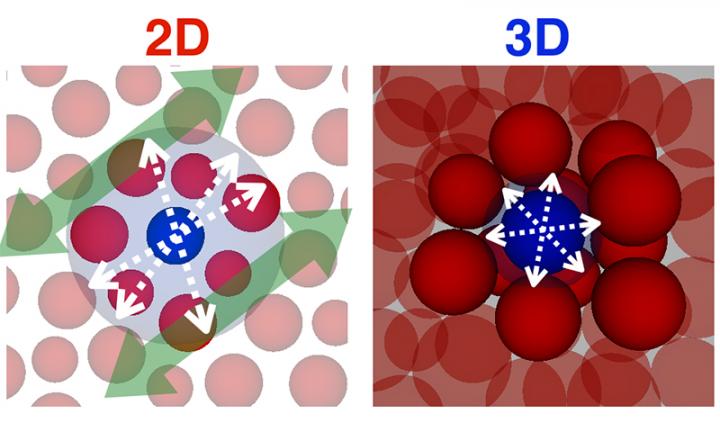Supercomputer simulation reveals 2-D glass can go infinitely soft

Left and right figures are schematic diagrams of glassy solid in two and three dimensions. Modality of the dynamics of glassy solid in different dimensions is illustrated. In three dimensions, a particle vibrates inside a cage formed by neighboring particles, due to the densely packed condition of the particles, and intermittently goes out of the cage. In two dimensions, long-wavelength vibrational sound waves induce coherent motion of the particles with a large amplitude that can in principle exceed the length scale of particle radii (the aqua colored circle on the left indicates that the caged particle can move a large distance). Credit: Hayato Shiba
“Imagine if we could make a sheet of glass, which has a two-dimensional (2D) planate shape,” says Dr. Hayato Shiba, of Tohoku University's Institute for Materials Research (IMR). “In such a confined spatial dimension, a variety of novel phenomena takes place in usual “periodic” systems (crystals, spin systems etc.). This is due to the thermal motion of the constituents taking place on a larger scale because of the limited spatial dimensions.”
Such enhanced thermal motion is known to induce new physical phenomena which Shiba, and his research team of Yasunori Yamada (IMR), Takeshi Kawasaki (Nagoya University) and Kang Kim (Osaka University), hope will lead the development of new functional materials and devices necessary for the realization of energy-saving societies.
However, it is still uncertain whether 2D glass, as an “non-periodic” system, exhibits such enhanced thermal motions.
“Our result indicates that 2D glass can become soft, gradually and forever, as we go to the macroscopic scales. Consequently, the vibration amplitude becomes infinite because of the large-scale motions,” says Shiba.
“In other words, such materials might exhibit strong responses to external fields or deformation. The thermal vibration is perfectly different from that in a 3D glass, and it can even alter the fundamental nature of vitrification and glassy phase transition.”
In the experiments, 2D glass was experimentally realized using colloidal systems, and can also be realized using other soft and hard materials.
Media Contact
All latest news from the category: Materials Sciences
Materials management deals with the research, development, manufacturing and processing of raw and industrial materials. Key aspects here are biological and medical issues, which play an increasingly important role in this field.
innovations-report offers in-depth articles related to the development and application of materials and the structure and properties of new materials.
Newest articles

A universal framework for spatial biology
SpatialData is a freely accessible tool to unify and integrate data from different omics technologies accounting for spatial information, which can provide holistic insights into health and disease. Biological processes…

How complex biological processes arise
A $20 million grant from the U.S. National Science Foundation (NSF) will support the establishment and operation of the National Synthesis Center for Emergence in the Molecular and Cellular Sciences (NCEMS) at…

Airborne single-photon lidar system achieves high-resolution 3D imaging
Compact, low-power system opens doors for photon-efficient drone and satellite-based environmental monitoring and mapping. Researchers have developed a compact and lightweight single-photon airborne lidar system that can acquire high-resolution 3D…





















